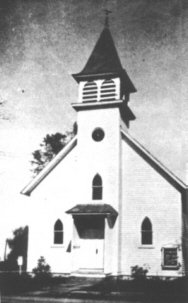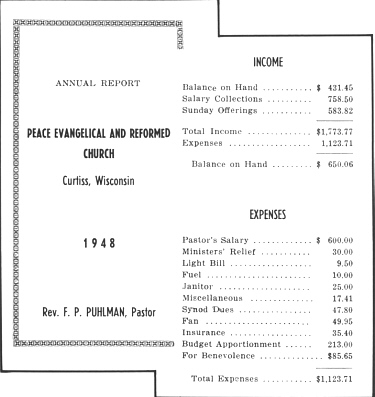Church: Curtiss, Wis., Peace Reformed
History
Contact:
janet@wiclarkcountyhistory.org
Surnames: Boehm, Schildknecht, Arpke,
Ecke, Bartels, Kiessig, Hake, Gosse, Smith, Schulz, Schumacker, Koerner, Erier,
Mahisted, Horn, Miller, Kraut, Neuhaus, Strade, Peissig, Koerner, Lahr, Buss,
Gosse, Zenzil, Lapp, Schmidt, Horn, Huenernan, Bauer, Rosenau, Hartman,
Franzmier, Schmiechen, Sturner, Gruther, Leonhardt, Puhlman, Jake, Dietrich,
Odland
----Source: Contributed by Eva Schiszik
History
of Peace Reformed Church,
Curtiss, Clark County Wisconsin
Contributed by Eva
Schiszik
|
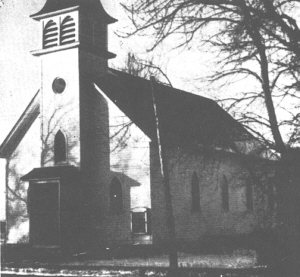 |
The first services in the
Reformed faith were held in what was known as 'Boehm's Hall' early in the
spring of 1905. Rev. Theophile Schildknecht and Rev. W. A. Arpke alternating
as pastors. It was soon decided that a hall was inadequate for a church so
on August 6th, 1905 they organized with the following charter members:
August Ecke, Rudolph Bartels, Christ Kiessig, Adolph Hake, Henry Gosse,
Charles Smith, Carl Schulz, Johan Schumacker, Winzeng Boehm, Moritz Koerner,
August Erier, John Mahisted, Louis Horn and John Miller Jr. The first church
officers were Moritz Koerner and Christ Klessig, elders; August Ecke and
Adolph Hake, trustees; August Ecke was chosen secretary and Adolph Hake
treasurer. John Mahisted was superintendent of the Sunday School. The sum of
$2,000.00 was borrowed from the Sheboygan Classis with which to build the
church. Articles of Incorporation were filed with the Register of Deeds on
September 30, 1905. Since this was a German speaking community it was given
the name 'Reformed Friedens Gemeinde'. |
In addition to the names on the charter the following have been
prominent members of the congregation: Mr. and Mrs. Charles Miller, Mr. and Mrs.
Frank Kraut, Mr. and Mrs. Gerhard Neuhaus, Mr. and Mrs. Fred Strade, Mr. and
Mrs. H. J. Peissig and Mr. and Mrs. Ervin Koerner.
|
Much lumber and labor was
donated and on December 2nd, 1905 the church edifice was dedicated and plans
were made for the first Christmas in the new church. Young people made trimmings
for the Christmas Tree. It was a beautiful sight when the tree was being lit
with real wax candies while the children sang "Der Christbaum is der Schonste
Baum". The elders stood ready with water in case of fire but none ever occurred.
To the right: Interior of Reformed Church - Christmas,
1905. > |
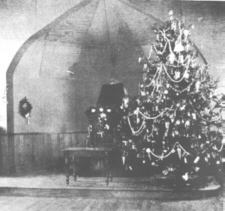 |
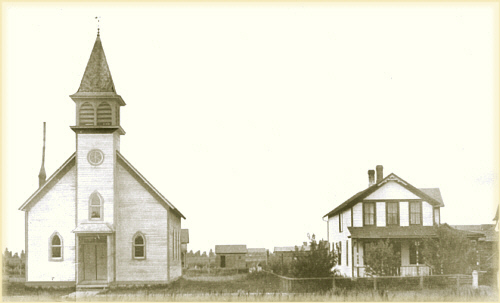
|
In March 1906 pastor W. H. Lahr came to serve the congregation. He and his
wife had 5 children: Cordelia, Edith, Marie, Franklin and Evelyn. They were
capable leaders and a choir and young people's society were organized. The young
people met once a month in the homes or the entrance of the church which was
also known as the school room. After devotions were held, games were played.
Once a year they had a 'Basket Social'.
Summer Vacation Bible School was
organized, all children of school age attending. The pastor taught all classes.
School lasted six weeks with regular school hours. Not only did they study the
Bible but the German language as well. The hard part was translating from
English into German. At the end of summer school there was a 'Kinderfest', a
picnic in the woods on the corner of E and 29. The highway has taken away most
of the picnic grounds. Ball throwing games were played. There was always a fish
pond or grab bag and plenty of fresh home- made ice cream. Men took turns
turning the hand-cranked ice cream freezer and chipping ice from large cakes
which had been cut from a river in winter and packed in sawdust for summer use.
Ice cream sold for 5 cents a dish or cone, pop 5 cents a bottle. Cracker jacks 5
cents a box - the prize in each box nearly worth the price paid for it! Men
had a bratwurst stand. |
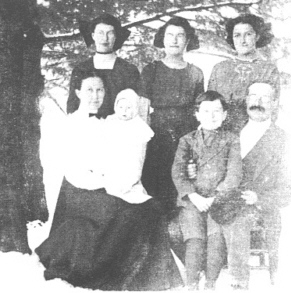
Pastor W. H.
Lahr and family, 1906 - 1911
(Enlarge) |
Life those early years was far different from today. There were no
automobiles, no electricity, no snow-plowed roads in winter. Most people walked
to church. Some lived too far away or had small children. They used horse drawn
vehicles, a big sleigh in winter and a surrey in summer. Bad weather never
stopped them!
Times were hard those first years. Early settlers starting on unimproved
cut-over land had little money but shared everything with their pastor. At
butchering time there was always a basket of meat and sausage. During the year a
chicken, roll of butter, or even an occasional loaf of home baked rye bread. An
excerpt from the annual meeting notes of 1906 read "Each family furnished one
cord of wood or paid $1.00".
In 1906 the Ladies Aid was organized. They met in the homes once a month,
each member paying 10 cents whether they at- tended or not. The pastor always
had short devotions and the ladies would sew carpet rags for rugs and do other
handiwork. Each lady made a quilt block which was set together for a quilt and
raffled off at a fall bazaar.
Mission fest dinners were served in what was the old school house at that
time (The white building just south of the Alliance Church). There was an old
wood cook stove but no dishes or cooking utensils so everything had to be
brought from home. Men carried water in milk cans. Most everyone raised chickens
so a chicken dinner was served. Everything that could be prepared at home was
brought in ready cooked. There was no set price for the dinner, but a free will
offering was taken. Money went to Missions or Mission House in Plymouth.
For the Sunday collection a coin was placed in the 'Kiingel Beutel', sort of
a bag on a stick, but at the end of the year every family gave a donation of
$10.00 or more according to their means. $2.50 per confirmed member was sent to
the Synod. Upon confirmation, members that paid their dues could vote. Men sat
on the right side of the church, women and children on the left.
When a member died the bell would toll and again the day of the funeral when
the horse drawn hearse was sighted it would toll until all were in the church.
Members of the confirmation class of 1907 were Elizabeth Buss, Tina Gosse,
Hulda Gosse, Alma Kiessig, Edgar Ecke, Walter Hake and Albert Zenzil.
In 1908 Bethany Reformed Church in the Township of hoard was organized with
pastors of the Reformed Church of Curtiss also conducting services there. Early
pastors had no transportation so they walked. On occasions like funerals they
would borrow a horse and vehicle from a member of the congregation.
In 1910, 2 1/2 acres of land was bought from Jake Lapp for $350.00 for the
purpose of a cemetery. Members wishing lots were to pay $10.00 per lot. Each
member would also work one day or pay $1.00. This is the present Pine Hill
Cemetery. On November 22, 1911, a call was extended to Pastor A. George Schmidt
to succeed pastor Lahr.
In 1912 the Louis Horn residence was bought for $1300.00 for a parsonage. At
the January meeting in 1914 it was voted to put a basement under the parsonage.
In the summer of 1915 all the pastors of the Sheboygan Classis held their
convention in Curtiss. The ladies of the congregation served dinners and suppers
in the village hall (old school house). Nights were spent with the members.
Up to this time pastors from Curtiss also conducted services at Trinity
Reformed Church in Thorp. Many trains passed through Curtiss, both passenger and
freight, so the trip to Thorp was made by train. Since this was inconvenient it
was decided to discontinue going to Thorp.
In 1916 a call was extended to pastor N. F. Janssen to succeed Pastor
Schmidt. In 1917 there was an English service in the evening of the first Sunday
of every month, Bethany of Hoard to have forenoon service.
In 1918 Pastor Wm. Huenernan came to serve the congregation. He was the first
pastor to own an automobile. By 1921 the envelope system was introduced and
collection plates were used in place of the 'Klingel Beutel'. It was also noted
that Bethany Reformed Church was to pay the Curtiss congregation $100.00 per
year as their share towards the pastor's salary. Pastor Hueneman stayed until
the end of 1921.
In March 1922 Pastor J. M. Bauer took up duties to serve the congregation.
During this time Peace Church joined with Irnrnanuel Reformed Church in Colby and
pastors lived in Colby.
In 1925 the Curtiss congregation voted to pay $350.00 as their share of the
pastor's salary. The next year it was increased to $400.00. The organist and the
janitor were each to receive $10.00 per year.
Student pastor Julius Rosenau served from July I st, 1925 until September
1927.
In 1927 Rev. Herman Hartman served all three congregations. By now most
sermons were in English, but the older members still wanted one Sunday a month
in the German language. The last record written in German was of the annual
meeting of January, 1930.
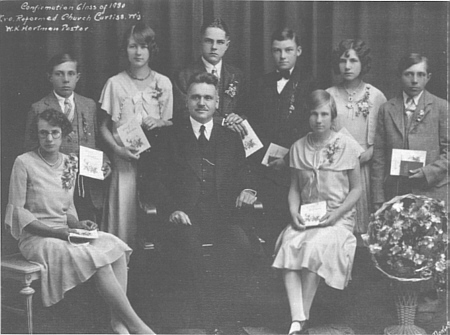
1930
Confirmation class with Pastor W. H. Hartman
In 1931 it was voted to charge nonmembers $25.00 for the use of the church
for funerals. The same year Bethany congregation was granted a release from the
Colby, Curtiss charge to become an independent congregation calling Rev. Paul
Franzmier of Greenwood to hold services once a month for $8.00 per Sunday. They
continued this way until the summer of 1952 when they dissolved the
congregation.
In 1932 the parsonage was sold to Otto Sturner for $500.00. The English
language was declared the official language.
In 1937 Rev. Siegfried Schmiechen was called. At this time the Evangelical
Churches and the Reformed Churches merged. A new constitution was adopted and
the name changed to Peace Evangelical and Reformed Church.
In May 1942 Rev. David Gruther carne to serve the congregation.
The Ladies Aid bought a large cupboard and donated dishes. In bad weather
they would meet in the village hall instead of the homes in the country. In the
fall there was a Harvest Festival. Members brought all kinds of produce, apples,
canned fruits of every kind and good clothing to the church which was taken to
the Winnebago Indian Mission School in Neillsville. Rev. Gruther died suddenly
of a heart attack in 1945. Rev. Robert Leonhardt served from December 1945 until
July 1947.
|
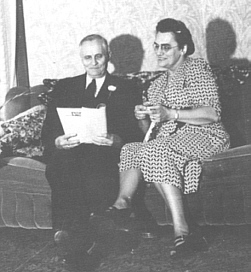 |
In September 1947 Rev. Franz Paul Puhlman accepted the call from the
congregation. During his pastorate a furnace was installed in the church, the
money having been given in memory of Mr. and Mrs. Christ Klessig. An electric
chancel cross was given in memory of Mr. and Mrs. Frank Kraut. A large picture,
'In His Presence' was given in memory of Charles and Elmer Jakel. The
congregation bought a new electric organ and 1 00 new hymnals. The church was
painted, insulated and the roof reshingled.
< Pastor Paul Puhlman, 1947 - 1952. |
In 1952 Pastor Puhlman was granted his release and Rev. Siegried Dietrich was
called. He died the following year so Peace Church was without a pastor. In the
winter of 1952 Rev. Otis Odland of the Evangelical Lutheran Church held joint
services for the two congregations. In May 1953 Peace church disbanded and
joined the Evangelical Lutheran church to make a stronger parish. Services in
the church a mile west were discontinued and Peace church was used.
At first they decided to remodel Peace church but after careful consideration
of what it would cost they voted to dismantle the old church and build new. Most
material was used in the construction of the new church. Money from the
Evangelical Reformed Women's Guild and other donations was turned over to the
new parish.






